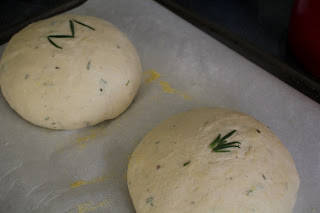As for pies, I've decided to take my skills up a notch and take a baking class at Zingerman's Bakehouse this September. I'm so excited! You can bet your sweet bippy I'll be taking my camera to document the whole experience.
In the meantime, I have a backlog entry to share.
Baking Outside the Pan
I love fresh bread and have made a few varieties of "American sandwich bread" - honey bran with sunflower nuts, oatmeal, and cinnamon swirl. But never before have I baked bread outside of a loaf pan. Until I did!First, I tried a King Arthur Flour bread mix for Alaskan sourdough bread. (I got this mix from my sister and brother-in-law. Thanks, Ange and Si!) The dough was easy enough to put together. The challenge was shaping the dough into boules. I read in The Bread Baker's Apprentice that this shape is important because it creates surface tension and allows bread to rise up and out; "the tight skin causes the dough to retain its cylindrical shape rather than spreading and flattening." I think my sourdough loaves rose fairly well for my first try.
Biga is Better?
Continuing my bread baking apprenticeship, I decided to try Reinhart's recipe for Italian panmarino or potato rosemary bread. (In part because I had recently acquired some fresh rosemary from a friend. Thanks, Laurel!) It was a two-day ordeal because it called for a biga, a pre-ferment used in place of regular baker's yeast. I mixed flour, instant yeast, and water until it was "soft and pliable, tacky but not sticky" with an internal temperature between 77 and 81 degrees Fahrenheit. Baking is much like chemistry, so specifics like that are very helpful.After several hours of fermenting, I had one steamy little biga! I kneaded it down and plopped it into the refrigerator.
Day two. There was nothing really special about adding the biga to the dough. I cut the biga into small pieces, let it sit for about an hour to take off the chill, and combined it with the rest of the ingredients: flour, salt, pepper, mashed potatoes, oil, rosemary, garlic, and some additional instant yeast. I had to add quite a bit of additional flour in this step to make it "tacky but not sticky." This may have impacted the rise and density of the bread, but it's hard to be sure. After several minutes of kneading, something called the windowpane test, and another temperature check, the dough was ready for its final fermentation: two hours to double in size.
I divided the dough into two parts, shaped it into boules, dusted with cornmeal, and added the final touch: embossed rosemary on the top.
The last pre-oven step is called proofing: another two hours to bask in room temperature and double in size. Et voila!
The author warns of using too much rosemary because it can be overpowering. I don't think I used too much, but the scent of the rosemary was much stronger than the actual flavor. The aroma really came out when the bread was toasted. Maybe I'll make dinner rolls with it the next time I have leftover mashed potatoes.









No comments:
Post a Comment